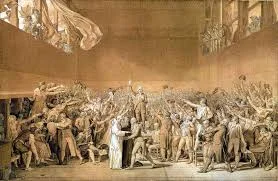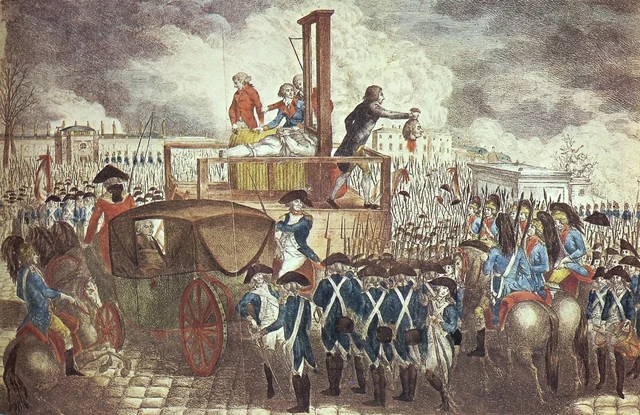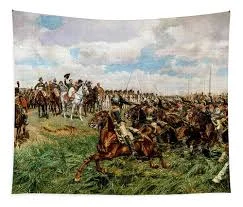-
Facing crippling debt, the monarch of France, King Louis XVI assembles the Three Estates. Louis wishes to raise the taxes on the citizens of France, but law states that he can only do so with the approval of the Three Estates. However, what Louis did not predict was that the First Estate and the Second Estate would vote to only raise taxes on the Third Estate. This angers members of the Third Estate, who represent over 95 percent of the French population.
-
 The National Assembly was created because of the withdrawal of the Third Estates because they weren’t being called upon on the creation of tax laws. The members gathered together to submit the single constitution to Louis where he was practically forced to accept it or he would be killed. Their main goal was to form a constitutional monarchy.
The National Assembly was created because of the withdrawal of the Third Estates because they weren’t being called upon on the creation of tax laws. The members gathered together to submit the single constitution to Louis where he was practically forced to accept it or he would be killed. Their main goal was to form a constitutional monarchy. -
The storming of the Bastille was one of the important events in the French Revolution. In Paris on July 14, 1789, a group of rebels stormed the Bastille, a prison and royal stronghold. The Bastille falls and the French Revolution starts representing victory of common people against monarchy.
-
Louis XVI, the king of France, attempted to flee as the French Revolution continued to get increasingly extreme. On the 20th of June Louis and his family had disguised themselves and made their way to the border. However, someone recognized them and they were apprehended in the town of Varennes and brought back to Paris where they became prisoners. This event was intended to address the distrust and resentment towards the monarchy. This showed the king's lack of commitment to the revolution.
-
The National Convention declared France a republic on September 22, 1792. This means that France would need a new constitution after a year of agreeing on the 1791 Constitution.
-
 After being convicted for treason, King Louis XVI was executed by the guillotine in Paris. The announcement of his death has horrified the monarchs. This caused them to form the coalitions to fight for the revolution of France. His death had intensified the revolutions, leading to further radicalization and more conflicts.
After being convicted for treason, King Louis XVI was executed by the guillotine in Paris. The announcement of his death has horrified the monarchs. This caused them to form the coalitions to fight for the revolution of France. His death had intensified the revolutions, leading to further radicalization and more conflicts. -
After Louis and Marie tried to escape things became more heated in France. The French didn’t want to listen to Austria so France declared war. They saw King Louis as a trait for trying to escape he was removed from his position as king and France became a republic. This didn’t appease the French so they executed Louis and the true Reign of terror was unfolded.
-
The leader of the radical Jacobin faction was Maximilien Robespierre. They rose to power and enforced the Reign of Terror, during which thousands of suspected enemies of the revolution were executed. However, Robespierre was arrested and guillotined because of the fear and opposition to his rules that grew. His death had marked the end of one of the most extreme phases in the revolution and led to a more moderate government.
-
The directory was a five-member committee that governed France for about four years. It was established after the fall of the National Convention and the end of the Reign of Terror. This aimed to create a more stable government and help to restore the order in France.
-
Napoleon becomes First Consul after overthrowing the Directory in a coup d'etat. Napoleon established himself as the First Consul of France, which effectively marked him as the ruler of the Country. This shows the beginning of Napoleon's rise to power.
-
The battle of Marengo was fought between the French army under Napoleon and the Austrian army in northern Italy. It was one of the most important battles in the French Revolutionary war. It was the reason Napoleon had secured the position as the First Consul and marked a turn in his military career. The French victory at Marengo led to the signing of the Treaty of Luneville, which had ended the war.
-
The Treaty of Amiens was signed on March 27th, 1802, between the French Republic and the United Kingdom of Great Britain and Ireland. It marked the end of the French Revolutionary Wars and the beginning of a brief period of peace between the two nations.
-
In the Notre Dame Cathedral, where the grand ceremony was happening, Napoleon had stood up and took the crown from the pope. He told the viewers that he had led the French in many victories and had saved the French people, resulting in him being worthy of becoming emperor. He placed the crown on his head. This symbolizes that he owes his authority to himself and not the church or the pope. This caused France to change from a republic into an empire with him holding the most power.
-
Napoleon’s many reforms in government included the Napoleonic Code which marks the uniform laws of France. He had also changed the French education. He declared France as a hereditary empire and crowned himself the emperor. This code was the main influence to many of the civil codes of the countries of continental Europe and Latin America. The Diversity of the laws were the dominant characteristics of the legal order.
-
 Napoleon and his army had won a decisive victory against the Russian military. Napoleon's French forces outnumbered the Russian troops by approximately 22,000 soldiers, which showed Napoleon's advantage. This caused the French to achieve significant victory, which forced the Russians to retreat across the Alle River. This achievement had led to the Treaty of Tilsit marking the end of the Fourth Coalition War.
Napoleon and his army had won a decisive victory against the Russian military. Napoleon's French forces outnumbered the Russian troops by approximately 22,000 soldiers, which showed Napoleon's advantage. This caused the French to achieve significant victory, which forced the Russians to retreat across the Alle River. This achievement had led to the Treaty of Tilsit marking the end of the Fourth Coalition War. -
The Invasion of Russia started because Napoleon sought to punish Russia for defying his Continental System. This Continental system was a blockage against Britain. Napoleon had led more than 600,000 soldiers into Russia, however, the Russians had burned their cities and resources to strave the incoming French army. Due to the harsh winter weather and lack of supplies, Napoleon was forced to retreat, resulting in a horrific loss of troops. Only about 100,000 troops had survived.
-
The Battle of Waterloo was the final battle of the French Revolution and it was the last battle Napoleon Boneparte ever fought in. The Battle of Waterloo was fought in present day Belgium. Napoleon’s French forces were outnumbered by the combined armies of the English and the Prussians, led by British officer the Duke of Wellington. When Napoleon was defeated, the French throne was once again given to King Louis XVIII.